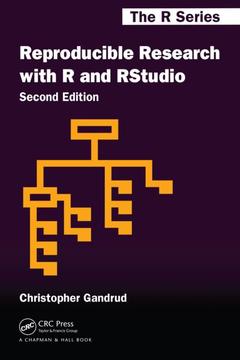Reproducible Research with R and RStudio (2nd Ed.) Chapman & Hall/CRC The R Series
Auteur : Gandrud Christopher

Reproducible Research with R and RStudio, Second Edition brings together the skills and tools needed for doing and presenting computational research. Using straightforward examples, the book takes you through an entire reproducible research workflow. This practical workflow enables you to gather and analyze data as well as dynamically present results in print and on the web.
New to the Second Edition
- The rmarkdown package that allows you to create reproducible research documents in PDF, HTML, and Microsoft Word formats using the simple and intuitive Markdown syntax
- Improvements to RStudio’s interface and capabilities, such as its new tools for handling R Markdown documents
- Expanded knitr R code chunk capabilities
- The kable function in the knitr package and the texreg package for dynamically creating tables to present your data and statistical results
- An improved discussion of file organization, enabling you to take full advantage of relative file paths so that your documents are more easily reproducible across computers and systems
- The dplyr, magrittr, and tidyr packages for fast data manipulation
- Numerous modifications to R syntax in user-created packages
- Changes to GitHub’s and Dropbox’s interfaces
Create Dynamic and Highly Reproducible Research
This updated book provides all the tools to combine your research with the presentation of your findings. It saves you time searching for information so that you can spend more time actually addressing your research questions. Supplementary files used for the examples and a reproducible research project are available on the author’s website.
Getting Started
Introducing Reproducible Research
What
Is Reproducible Research?
Why Should Research Be Reproducible?
Who
Should Read This Book?
The Tools of Reproducible Research
Why Use
R, knitr/rmarkdown, and RStudio for Reproducible Research?
Book
Overview
Getting Started with Reproducible Research
The Big Picture: A
Workflow for Reproducible Research
Practical Tips for Reproducible
Research
Getting Started with R, RStudio, and knitr/rmarkdown
Using
R: the Basics
Using RStudio
Using knitr and rmarkdown:
the Basics
Getting Started with File Management
File Paths and Naming
Conventions
Organizing Your Research Project
Setting Directories
as RStudio Projects
R File Manipulation Commands
Unix-Like Shell
Commands for File Management
File Navigation in RStudio
Data Gathering and Storage
Storing, Collaborating,
Accessing Files, and Versioning
Saving Data in Reproducible
Formats
Storing Your Files in the Cloud: Dropbox
Storing Your
Files in the Cloud: GitHub
RStudio and GitHub
Gathering Data with R
Organize Your Data Gathering: Makefiles
Importing
Locally Stored Data Sets
Importing Data Sets from the Internet
Advanced
Automatic Data Gathering: Web Scraping
Preparing Data for Analysis
Cleaning Data for Merging
Merging
Data Sets
Analysis and Results
Statistical
Modelling and knitr
Incorporating Analyses into
the Markup
Dynamically Including Modular Analysis Files
Reproducibly
Random: set.seed
Computationally Intensive Analyses
Showing Results with Tables
Basic knitr Syntax for
Tables
Table Basics
Creating Tables from Supported Class R Objects
Showing Results with Figures
Including Non-Knitted Graphics
Basic
knitr/rmarkdown Figure Options
Knitting R’s Default
Graphics
Including ggplot2 Graphics
JavaScript Graphs with googleVis
Presentation Documents
Presenting
with knitr/LaTeX
The Basics
Bibliographies with
BibTeX
Presentations with LaTeX Beamer
Large knitr/LaTeX Documents: Theses, Books, and Batch Reports
Planning
Large Documents
Large Documents with Traditional LaTeX
knitr and
Large Documents
Child Documents in a Different Markup Language
Creating
Batch Reports
Presenting on the Web and Other Formats with R Markdown
The
Basics
Further Customizability with rmarkdown
Slideshows
with Markdown, rmarkdown, and HTML
Publishing HTML Documents
Created by R Markdown
Conclusion
Citing Reproducible Research
Licensing Your
Reproducible Research
Sharing Your Code in Packages
Project
Development: Public or Private?
Is it Possible to Completely Future
Proof Your Research?
Bibliography
Index
Date de parution : 06-2015
Ouvrage de 295 p.
15.6x23.5 cm
Disponible chez l'éditeur (délai d'approvisionnement : 15 jours).
Prix indicatif 66,70 €
Ajouter au panier

